


In a move to protect his country from the threats posed by North Korea's communist forces, South Korean President Yoon Suk-yeol has ordered measures to eliminate anti-state elements. The decision comes amid ongoing tensions between the two nations and raises concerns about potential future conflicts. The move has sparked debate and speculation over the effectiveness and consequences of such actions.
South Korea Cracks Down on Anti-State Elements Amid North Korean Tensions
South Korean President Yoon Suk-yeol has ordered measures to eliminate anti-state elements in a move to protect his country from the threats posed by North Korea's communist forces. The decision comes amid ongoing tensions between the two nations and raises concerns about potential future conflicts.
Background:
Tensions between North and South Korea have been simmering for decades, with the two nations technically still at war since the Korean War ended in 1953 with an armistice, not a peace treaty. North Korea has repeatedly threatened South Korea with military action and has conducted nuclear and missile tests in violation of UN resolutions.
South Korea has long maintained a military alliance with the United States, which has stationed troops in the country since the Korean War. In recent years, the US has increased its military presence in the region in response to North Korea's provocations.
The Crackdown:
President Yoon's order targets individuals and organizations deemed to be a threat to national security. The measures include:
The move has sparked debate and speculation over its effectiveness and consequences. Critics argue that the crackdown is too broad and could lead to human rights violations and political repression. Supporters argue that it is necessary to protect the country from external threats and prevent internal subversion.
Concerns About Conflict:
The crackdown has raised concerns about the possibility of future conflicts between North and South Korea. Some analysts believe that the South's actions could provoke a military response from the North, which has a history of aggression.
Others argue that the crackdown is a necessary step to deter North Korea's provocations and maintain stability in the region.
Top 5 FAQs and Answers:
1. What are anti-state elements? Anti-state elements refer to individuals or organizations that are perceived as a threat to the national security or stability of a country. These may include political dissidents, activists, and organizations that advocate for radical or revolutionary changes.
2. Why is South Korea cracking down on anti-state elements? South Korea is cracking down on anti-state elements in response to the continued threats posed by North Korea's communist forces. The government believes that these elements could be used by North Korea to destabilize South Korea or undermine its national security.
3. What are some examples of anti-state activities? Anti-state activities can include political dissent, criticism of the government, espionage, sabotage, and terrorism.
4. How will the crackdown affect freedom of expression and assembly in South Korea? The crackdown may lead to restrictions on freedom of expression and assembly in South Korea. The government has stated that it will take measures to prevent anti-state elements from using these freedoms to threaten national security.
5. What are the potential consequences of the crackdown? The crackdown could have several potential consequences, including human rights violations, political repression, and increased tensions between North and South Korea.

Naveed and Sajid Akram are the alleged shooters behind the anti-Semitic terror attack at Bondi Beach in Sydney, Australia, which left 16 people dead and dozens injured. Naveed, a bricklayer, had previously been investigated for his support for Islamic State and had a history of boxing. His father, Sajid, was fatally shot during the attack and was known to have legal firearms registered to him. The suspects' Islamic teacher has publicly condemned the attack, revealing that Naveed had been awarded a certificate for mastering the Quran.

In a shocking and distressing turn of events, it has been confirmed that the deadly terror attack at Sydney's Bondi Beach was carried out by a father-son duo. Authorities have stated that they are not looking for any additional suspects and that the death toll has risen to 16 people, with at least 40 others injured. The incident, which occurred during a Jewish community event, has been classified as a terrorist attack and has garnered support for the country's Jewish community from top government officials.

In his departure statement, Indian Prime Minister Narendra Modi announced his visit to three countries, Jordan, Ethiopia, and Oman, which share both cultural and contemporary relations with India. The tour, which marks 75 years of diplomatic relations between India and Jordan, will see PM Modi engaging in discussions with top leaders of these nations, including King Abdullah II and Prime Minister Jafar Hassan. The tour presents an opportunity for India to strengthen its ties with these countries.

In an attack at a public Hanukkah celebration at Bondi Beach, Sydney, a father-son duo opened fire, killing 16 people and injuring 40. While one gunman has been identified as Naveed Akram, the other has been identified as Sajid Akram, both Pakistani nationals. It was revealed that Sajid Akram had held a gun license for 10 years, and his son was previously investigated by Australia's domestic intelligence agency for his ties to an IS terrorism cell. The shooting has been condemned as a deliberate targeting of the Jewish community on the first day of Hanukkah.

The two men responsible for the Bondi Beach mass shooting have been revealed as a father and son duo. New South Wales police have identified the shooters as 24-year-old Naveed Akram and his father, Sajid Akram, aged 50. Naveed was apprehended at the scene and is currently in a critical but stable condition under police guard. Meanwhile, Sajid, who owned a fruit shop, was killed at the scene of the attack.

The city of Los Angeles is on high alert after a horrific mass shooting at a Hanukkah celebration in Sydney, Australia, which claimed the lives of 16 people. In response, the LAPD has announced additional patrols at Jewish facilities and events throughout the county, while also expressing solidarity with the Jewish community. The public is advised to remain vigilant and report any suspicious activity, and local religious institutions are urged to review their security protocols. The tragic incident serves as a reminder of the need for global unity in standing against hate and violence.

In a statement released on Sunday, Hamas confirmed the death of one of its top commanders, Raed Saad, who was killed in an Israeli strike outside of Gaza City. Israel had identified him as a key figure responsible for a 2023 attack that led to the recent conflict in Gaza. Amidst ongoing tensions, Hamas has also announced the appointment of a new commander, vowing to respond to Israel's "aggression".

Leaders from around the world expressed shock and solidarity after a terrorist attack at Bondi Beach in Sydney, Australia killed at least 11 people during a Hanukkah event. Australian police have declared the incident a terrorist attack and are working to identify those responsible. Indian Prime Minister Narendra Modi strongly condemned the attack, stating that India has zero tolerance towards terrorism. Leaders from Europe, the Middle East, and the Pacific also sent messages of condolence and denounced the violence.

In a shocking turn of events, the identity of one of the shooters responsible for the massacre at Bondi Beach has been revealed. Naveed Akram, a 24-year-old from Sydney's south-west, was identified by authorities after his involvement was confirmed. His family's home is currently being searched by police, and Akram himself is in custody after being shot and treated by emergency services. This tragic event has sent shockwaves through Australia's most famous beach.

The Israel Defense Forces (IDF) has announced the death of Ra'ad Sa'ad, the head of Hamas' Weapons Production Headquarters and one of the architects of the 2023 massacre. The IDF has stated that Sa'ad's death significantly degrades Hamas' ability to rebuild its military capabilities. He had been actively violating the U.S.-brokered ceasefire and was considered a high-ranking member of Hamas in Gaza.